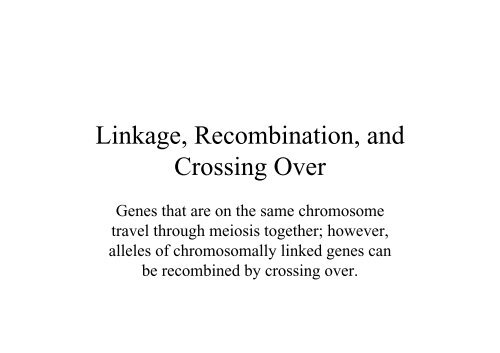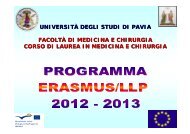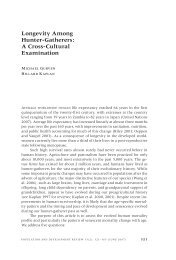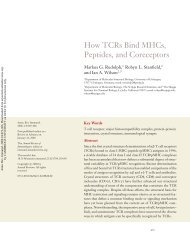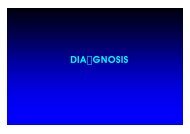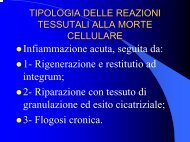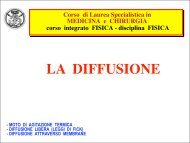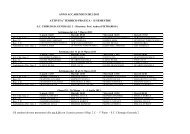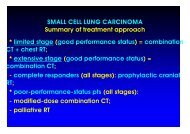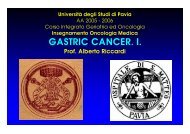Linkage, Recombination, and Crossing Over
Linkage, Recombination, and Crossing Over
Linkage, Recombination, and Crossing Over
You also want an ePaper? Increase the reach of your titles
YUMPU automatically turns print PDFs into web optimized ePapers that Google loves.
<strong>Linkage</strong>, <strong>Recombination</strong>, <strong>and</strong><br />
<strong>Crossing</strong> <strong>Over</strong><br />
Genes that are on the same chromosome<br />
travel through meiosis together; however,<br />
alleles of chromosomally linked genes can<br />
be recombined by crossing over.
A Chromosome<br />
Map
Heterozygous<br />
for two traits<br />
Gametes:<br />
GR;<br />
Gr;<br />
gR;<br />
gr;<br />
GgRr<br />
Phenotypes:<br />
YeRo-YeWr-GrRo-GrWr<br />
9 - 3 - 3 - 1<br />
3
Linked Genes Do Not<br />
Assort Independently
<strong>Linkage</strong> Phases:<br />
Coupling <strong>and</strong> Repulsion
<strong>Crossing</strong> <strong>Over</strong><br />
MAX 50% recombination
Multiple<br />
Crossovers
<strong>Crossing</strong> <strong>Over</strong> Occurs in<br />
Prophase of Meiosis I
Key Points<br />
• <strong>Linkage</strong> between genes is detected as a deviation<br />
from expectations based on Mendel’s Principle of<br />
Independent Assortment.<br />
• The frequency of recombination measures the<br />
intensity of linkage. In the absence of linkage, this<br />
frequency is 50 percent; for very tight linkage, it is<br />
close to zero.
Key Points<br />
• <strong>Recombination</strong> is caused by a physical exchange between<br />
paired homologous chromosomes early in prophase of the<br />
first meiotic division after chromosomes have duplicated.<br />
• At any one point along a chromosome, the process of<br />
exchange (crossing over) involves only two of the four<br />
chromatids in a meiotic tetrad.<br />
• Late in prophase I, crossovers become visible as<br />
chiasmata.
Chromosome Mapping<br />
Linked genes can be mapped on a<br />
chromosome by studying how often<br />
their alleles recombine.
Observable Outcomes of<br />
<strong>Crossing</strong> <strong>Over</strong><br />
• Formation of chiasmata in late prophase.<br />
• <strong>Recombination</strong> between genes on opposites<br />
sides of the crossover point.
Genetic Map Distances<br />
• The distance between<br />
two points on the<br />
genetic map of a<br />
chromosome is the<br />
average number of<br />
crossovers between<br />
them.
<strong>Recombination</strong><br />
Mapping with a<br />
Two-Point<br />
Testcross
• The <strong>Recombination</strong> Frequency between vg<br />
<strong>and</strong> b is 18%<br />
• This is equal to 18 map units, or 18<br />
centiMorgans (cM) on the genetic map.
<strong>Recombination</strong> Mapping with a<br />
Three-Point Testcross
Determining the Gene Order<br />
• There are 3 possible gene orders<br />
1. sc - ec - cv<br />
2. ec - sc - cv<br />
3. ec - cv - sc<br />
• The two most common classes are the parentals.<br />
• Among the recombinant classes, the 2 rare classes<br />
represent the double crossovers.<br />
•<br />
The gene that is “switched” in the double crossover<br />
classes compared to the parental is the middle gene (in<br />
this case, ec).
Calculation of Map Distances
Interference <strong>and</strong> the Coefficient<br />
of Coincidence<br />
• Assuming independence, the expected<br />
frequency of double crossovers is 0.091 ×<br />
0.105 = 0.0095.<br />
• The observed frequency of double<br />
crossovers was 2/3248 = 0.0006.<br />
• A crossover in one region inhibited a<br />
crossover nearby.
<strong>Recombination</strong> Frequency <strong>and</strong><br />
Genetic Map Distance
<strong>Recombination</strong> Frequency <strong>and</strong><br />
Genetic Map Distance
Chiasma<br />
Frequency <strong>and</strong><br />
Genetic Map<br />
Distance
Key Points<br />
• The genetic maps of chromosomes are based on<br />
the average number of crossovers that occur<br />
during meiosis.<br />
• Genetic map distances are estimated by<br />
calculating the frequency of recombination<br />
between genes in experimental crosses.
Key Points<br />
• <strong>Recombination</strong> frequencies less than 20 percent<br />
estimate map distance directly; however,<br />
recombination frequencies greater than 20 percent<br />
underestimate map distance because multiple<br />
crossover events do not always produce<br />
recombinant chromosomes.<br />
• An average of one chiasma during meiosis is<br />
equivalent to 50 centiMorgans of genetic map<br />
distance.
Genetic Distance<br />
<strong>and</strong> Physical Distance
Key Points<br />
• In Drosophila, genes can be localized on maps of the<br />
polytene chromosomes by combining recessive mutations<br />
with cytologically defined deletions <strong>and</strong> duplications.<br />
• A deletion will reveal the phenotype of a recessive<br />
mutation located between its endpoints, whereas a<br />
duplication will conceal the mutant phenotype.<br />
• Genetic <strong>and</strong> cytological maps are colinear; however,<br />
genetic distances are not proportional to cytological<br />
distances.
<strong>Linkage</strong> Analysis in Humans<br />
Pedigree analysis provides ways or<br />
localizing genes on human<br />
chromosomes.
<strong>Linkage</strong> Between the ABO <strong>and</strong><br />
Nail-Patella Loci
Calculation of the <strong>Recombination</strong><br />
Frequency<br />
• 4/13 offspring (31%) in<br />
this pedigree are<br />
recombinant.<br />
• Combining data from<br />
many pedigrees, the<br />
genetic distance between<br />
the ABO <strong>and</strong> NPS1 loci is<br />
10 cM.<br />
• Molecular markers can<br />
also be mapped.
Key Points<br />
• <strong>Linkage</strong> between human genes can be detected by<br />
analyzing pedigrees.<br />
• Pedigree analysis also provides estimates of<br />
recombination frequencies to map genes on human<br />
chromosomes.
• The coefficient of coincidence (c) is the<br />
ratio of observed double crossovers to<br />
expected double crossovers.<br />
c = 0.0006 / 0.0095 = 0.063<br />
• Interference (I) = 1 - c<br />
I = 1 - 0.063 = 0.937
<strong>Recombination</strong> <strong>and</strong> Evolution<br />
<strong>Recombination</strong>—or the lack of it—<br />
plays a key role in evolution.
Evolutionary Significance of<br />
<strong>Recombination</strong><br />
• Meiotic recombination is a way of shuffling<br />
genetic variation to potentiate evolutionary<br />
change.<br />
• In sexually reproducing species,<br />
recombination can allow favorable alleles of<br />
different genes to come together in the same<br />
organism.
Inversions Suppress <strong>Recombination</strong><br />
in Heterozygotes
Double Crossovers in Inversion<br />
Heterozygotes
The Human X <strong>and</strong> Y<br />
Chromosomes
Genetic Control of<br />
<strong>Recombination</strong><br />
• The products of many genes are involved in<br />
recombination.<br />
• <strong>Crossing</strong> over does not occur in Drosophila<br />
males.<br />
• The amount of recombination varies among<br />
species.
Key Points<br />
• <strong>Recombination</strong> can bring favorable<br />
mutations together.<br />
• Chromosome rearrangements, especially<br />
inversions, can suppress recombination.<br />
• <strong>Recombination</strong> is under genetic control.
Chromosome 9 in Maize
Evidence that <strong>Crossing</strong> <strong>Over</strong><br />
Causes <strong>Recombination</strong>


